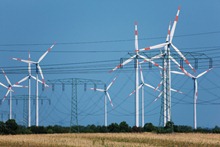Getting It Right: Windpower & Transmission Capacity
by Kate Galbraith, NEW YORK TIMES, September 12, 2010
 As the United States contemplates a clean-energy future, leadership is coming from a surprising place — Texas.
As the United States contemplates a clean-energy future, leadership is coming from a surprising place — Texas.
This state is well-known for producing oil and natural gas. But Texas also has erected far more turbines than any other state and now has nearly three times as much wind capacity as Iowa, which is ranked second. Forests of turbines have sprouted atop remote, scrubby mesas. If Texas were its own country, it would generate more wind power than all but five nations — the United States, China, Germany, Spain and India.
“Texas still has a long way to go to meet its future energy demand with an increased amount of clean energy, but there’s a lot of success to build on,” said Michael Brune, the executive director of the Sierra Club, a major environmental group based in San Francisco, who visited the state last week. Texas, he said, ranks second nationally in the creation of clean-energy jobs, after California.
The United States has big dreams for moving away from fossil fuels.
President Barack Obama has made the promotion of renewables central to his administration. A 2008 Department of Energy study found that the United States could, in theory, get 20 percent of its electricity from wind by 2030. Right now, however, that figure is less than 2 percent nationally. In Denmark, by contrast, about 20 percent of the electricity supply comes from wind.
In Texas, wind accounts for 6 percent of the electricity on the grid. But after a decade of rampant growth, wind is running into a significant constraint: There are too few transmission lines to carry the power. The wind turbines have mostly gone up in the western part of the state — hundreds of miles from the big cities in central and eastern Texas that need the power. The result is that on windy days, some turbines must shut down because there are not enough wires to transport the electricity they produce.
Lack of transmission is a national problem, especially for wind, which is often generated far from population centers. “The ability to site and build transmission is emerging as one of the highest risks facing the electric industry over the next 10 years,” according to a report last year from the North American Electric Reliability Corp., an industry group that sets operating standards for the grid.
Europe, similarly concerned, is hoping to build transmission lines under the North Sea, which would provide new ways to move electricity generated by offshore wind turbines and other renewable energy sources.
In Texas, state officials have moved aggressively to remedy the transmission deficiency. In 2008 regulators approved a $5 billion network of wires, which ultimately will stretch more than 2,300 miles, or 3,700 kilometers, around the state. The regulators are determining, one by one, exactly where each line will go. Construction on the first of the lines should start this autumn.
Unlike other states, Texas has a stand-alone power grid, making it easier to plan and site transmission lines. That effort has brought praise from renewable-energy advocates around the United States. The Texas process helped inspire a similar initiative in California, said V. John White, executive director of the Center for Energy Efficiency and Renewable Technologies, which is based in California. Mr. White said efforts there focused on supporting solar and geothermal power, as well as wind, and included more input from environmentalists.
But even in Texas — a state long accustomed to oil pipelines and other energy infrastructure — opposition to the transmission lines is mounting. Many landowners do not want to surrender their land to high-voltage power lines, even though they would be paid to do so. “The meters on the attorneys are running,” said Robert Weatherford, the president of Save Our Scenic Hill Country Environment, one of several groups fighting to keep two proposed power lines out of a scenic patch of central Texas, with partial success so far.
Besides transmission, Texas is grappling with other wind-related issues. One is cost. Long-term wholesale contracts for Texas wind power remain about twice as costly as generation from coal and nuclear plants, according to Michael E. Webber, the associate director of the Center for International Energy and Environmental Policy at the University of Texas in Austin.
A U.S. government tax credit brings down the cost substantially, however. [Read rest of story]


